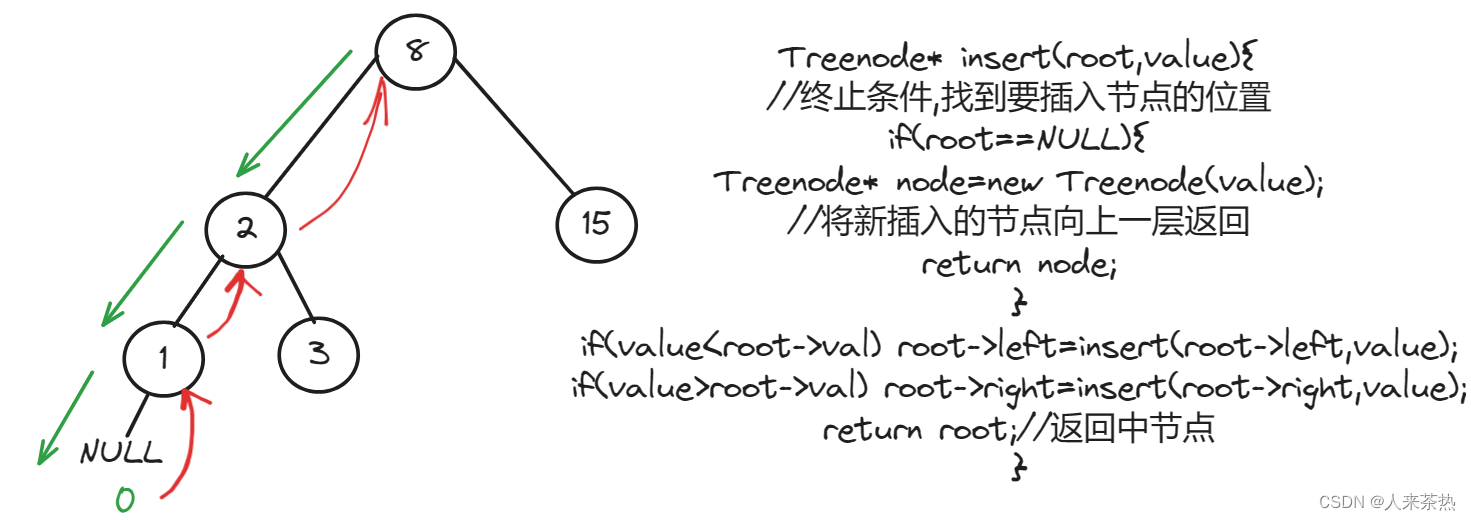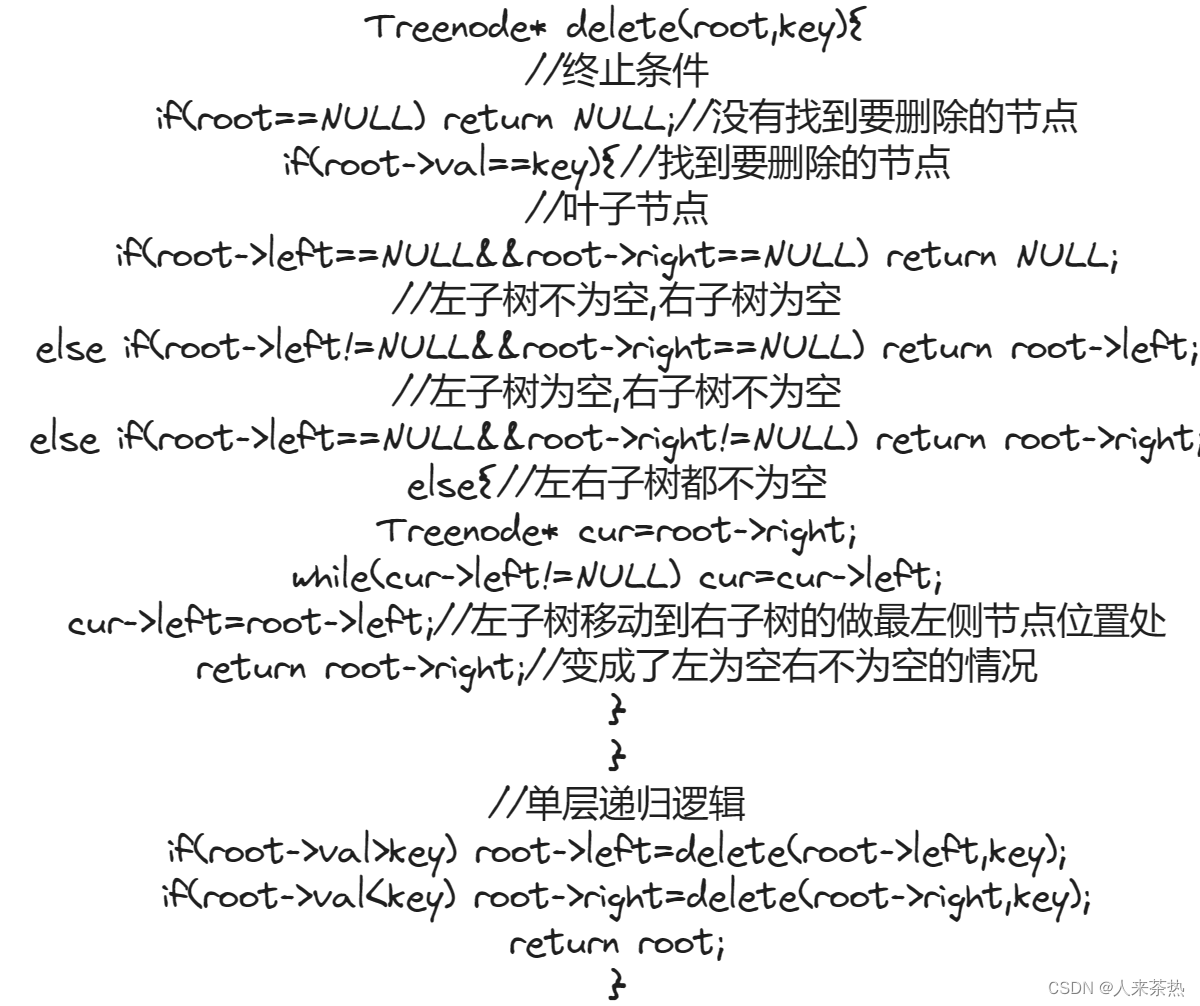day22 二叉搜索树的最近公共祖先 二叉搜索树中的插入操作 删除二叉搜索树中的节点
发布时间:2024年01月19日
题目1:235 二叉搜索树的最近公共祖先
题目链接:235 二叉搜索树的最近公共祖先
题意
找出二叉搜索树中两个指定节点的最近公共祖先
二叉搜索树中节点各不相同,且两个指定的节点均存在与二叉搜索树中,也不同
递归
递归三部曲:
1)递归函数的参数和返回值
2)终止条件
3)单层递归逻辑
使用二叉搜索树的性质:不用考虑前序,中序和后序遍历,直接使用二叉搜索树的性质,遇到目标节点直接返回
如果当前遍历的节点大于p,q,那么p和q公共祖先一定在该节点的左子树中,所以向左遍历;
如果当前遍历的节点小于p,q,那么p和q公共祖先一定在该节点的右子树中,所以向右遍历;
当前遍历的节点在p和q之间,那么当前节点一定是p和q的公共祖先,且一定是最近的公共祖先,因为p一定在左子树(右子树)中,q一定在右子树(左子树)中,所以当前遍历的节点一定是最近公共祖先

代码
/**
* Definition for a binary tree node.
* struct TreeNode {
* int val;
* TreeNode *left;
* TreeNode *right;
* TreeNode(int x) : val(x), left(NULL), right(NULL) {}
* };
*/
class Solution {
public:
TreeNode* lowestCommonAncestor(TreeNode* root, TreeNode* p, TreeNode* q) {
//终止条件
if(root==NULL) return NULL;
//单层递归逻辑
if(root->val>p->val && root->val>q->val){
TreeNode* left = lowestCommonAncestor(root->left,p,q);
if(left!=NULL) return left;
}
if(root->val<p->val && root->val<q->val){
TreeNode* right = lowestCommonAncestor(root->right,p,q);
if(right!=NULL) return right;
}
return root;
}
};迭代

代码
/**
* Definition for a binary tree node.
* struct TreeNode {
* int val;
* TreeNode *left;
* TreeNode *right;
* TreeNode(int x) : val(x), left(NULL), right(NULL) {}
* };
*/
class Solution {
public:
TreeNode* lowestCommonAncestor(TreeNode* root, TreeNode* p, TreeNode* q) {
while(root!=NULL){
if(root->val>p->val && root->val>q->val) root = root->left;
else if(root->val<p->val && root->val<q->val) root = root->right;
else return root;
}
return NULL;//没有找到
}
};题目2:701 二叉搜索树中的插入操作
题目链接:701 二叉搜索树中的插入操作
题意
将值value插入到二叉搜索树中,保证插入后的二叉树仍是二叉搜索树
插入任意一个节点都可以在叶子节点位置处找到该节点的位置,保证仍为二叉搜索树
递归
递归三部曲:
1)递归函数的参数和返回值
2)终止条件
3)单层递归逻辑

代码
/**
* Definition for a binary tree node.
* struct TreeNode {
* int val;
* TreeNode *left;
* TreeNode *right;
* TreeNode() : val(0), left(nullptr), right(nullptr) {}
* TreeNode(int x) : val(x), left(nullptr), right(nullptr) {}
* TreeNode(int x, TreeNode *left, TreeNode *right) : val(x), left(left), right(right) {}
* };
*/
class Solution {
public:
TreeNode* insertIntoBST(TreeNode* root, int val) {
//终止条件,要插入的位置
if(root==NULL){
TreeNode* node = new TreeNode(val);
return node;//将该节点返回给上一层
}
//单层递归逻辑
if(root->val>val) root->left = insertIntoBST(root->left,val);
if(root->val<val) root->right = insertIntoBST(root->right,val);
return root;
}
};迭代
代码
/**
* Definition for a binary tree node.
* struct TreeNode {
* int val;
* TreeNode *left;
* TreeNode *right;
* TreeNode() : val(0), left(nullptr), right(nullptr) {}
* TreeNode(int x) : val(x), left(nullptr), right(nullptr) {}
* TreeNode(int x, TreeNode *left, TreeNode *right) : val(x), left(left), right(right) {}
* };
*/
class Solution {
public:
TreeNode* insertIntoBST(TreeNode* root, int val) {
if(root==NULL){
TreeNode* node = new TreeNode(val);
return node;
}
TreeNode* pre;//NULL节点的父节点
TreeNode* cur = root;
while(cur!=NULL){
pre = cur;
if(cur->val>val) cur = cur->left;
else if(cur->val<val) cur = cur->right;
}
TreeNode* node = new TreeNode(val);
if(pre->val>val) pre->left = node;
else if(pre->val<val) pre->right = node;
return root;
}
};题目3:450 删除二叉搜索树中的节点
题目链接:450 删除二叉搜索树中的节点
题意
删除二叉搜索树中值为key的节点,保证二叉树仍未二叉搜索树,
利用二叉树的性质,找到要删除的节点进行删除,不用遍历整棵二叉树
递归
递归三部曲:
1)递归函数的参数和返回值、
2)终止条件 找到要删除的节点
3)单层递归逻辑

伪代码

代码
/**
* Definition for a binary tree node.
* struct TreeNode {
* int val;
* TreeNode *left;
* TreeNode *right;
* TreeNode() : val(0), left(nullptr), right(nullptr) {}
* TreeNode(int x) : val(x), left(nullptr), right(nullptr) {}
* TreeNode(int x, TreeNode *left, TreeNode *right) : val(x), left(left), right(right) {}
* };
*/
class Solution {
public:
TreeNode* deleteNode(TreeNode* root, int key) {
//终止条件
//没有找到满足条件的节点
if(root==NULL) return NULL;
//找到满足条件的节点,分类讨论
if(root->val==key){
//叶子节点
if(root->left==NULL && root->right==NULL) return NULL;
//左子树为空,右子树不为空
else if(root->left==NULL && root->right!=NULL) return root->right;
//左子树不为空,右子树为空
else if(root->left!=NULL && root->right==NULL) return root->left;
//左子树和右子树都不为空
else{
TreeNode* cur = root->right;//右子树
while(cur->left!=NULL) cur = cur->left;//右子树的最左侧叶子节点
cur->left = root->left;//root的左子树移动到右子树最左侧叶子节点的左孩子
//此时左为空,右不为空
return root->right;
}
}
//单层递归逻辑
if(root->val>key) root->left = deleteNode(root->left,key);
if(root->val<key) root->right = deleteNode(root->right,key);
return root;
}
};
文章来源:https://blog.csdn.net/qq_43773652/article/details/135684853
本文来自互联网用户投稿,该文观点仅代表作者本人,不代表本站立场。本站仅提供信息存储空间服务,不拥有所有权,不承担相关法律责任。 如若内容造成侵权/违法违规/事实不符,请联系我的编程经验分享网邮箱:chenni525@qq.com进行投诉反馈,一经查实,立即删除!
本文来自互联网用户投稿,该文观点仅代表作者本人,不代表本站立场。本站仅提供信息存储空间服务,不拥有所有权,不承担相关法律责任。 如若内容造成侵权/违法违规/事实不符,请联系我的编程经验分享网邮箱:chenni525@qq.com进行投诉反馈,一经查实,立即删除!
最新文章
- Python教程
- 深入理解 MySQL 中的 HAVING 关键字和聚合函数
- Qt之QChar编码(1)
- MyBatis入门基础篇
- 用Python脚本实现FFmpeg批量转换
- 领导看了就给我升职加薪的年终总结,我只花5分钟就写完了!
- Transformer(seq2seq、self-attention)学习笔记
- OpenHarmony之HDF驱动开发流程指导
- 统信UOS上生成软件网页版安装包
- vue保姆级教程----深入了解 Vue3与Vue2的区别对比
- 在 PyCharm 中高效使用 GitHub Copilot
- 原子操作以及原子操作类AtomicInteger简介
- PCB入门篇1:认识PCB及必要元件 【龙王山通信电子社电赛培训】
- java中文乱码解决方案大全
- leetcode贪心算法题总结(三)